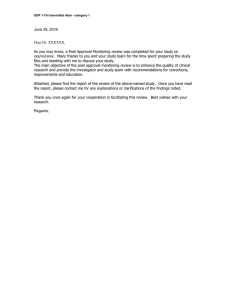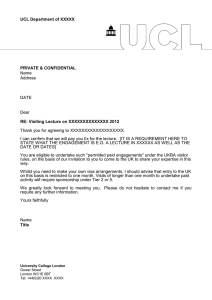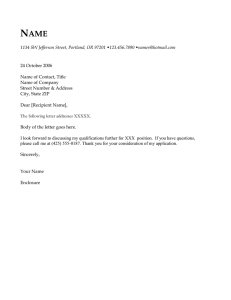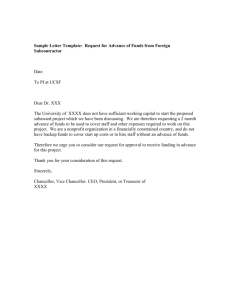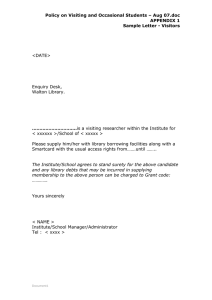This MLA packet will help students organize the Works Cited page
advertisement
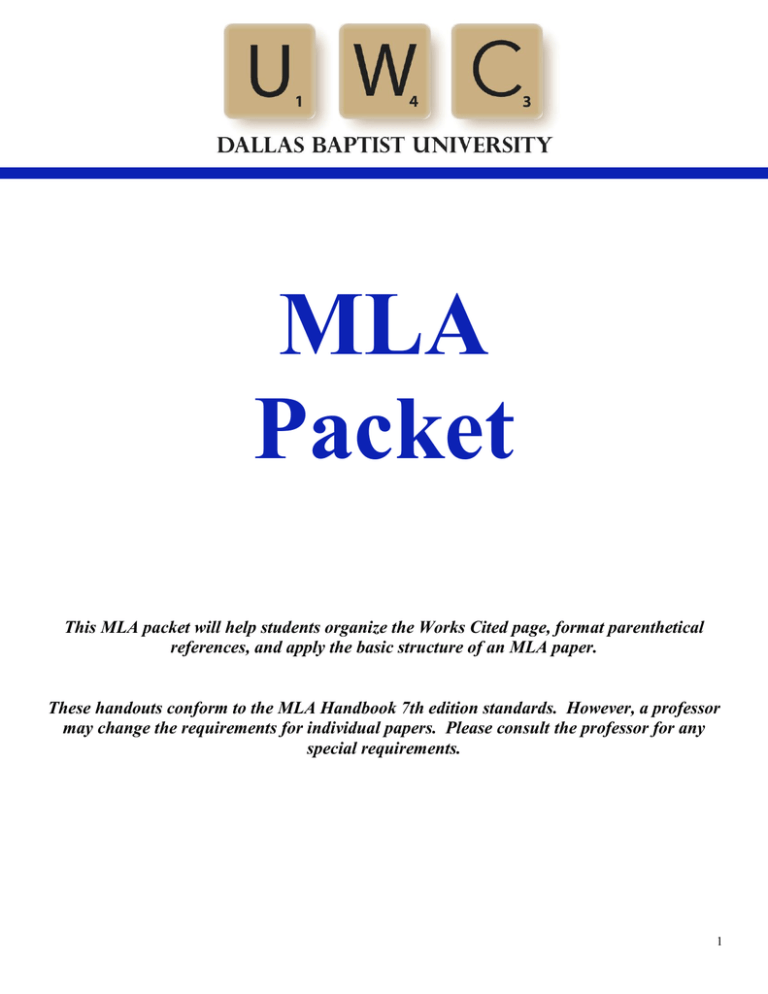
MLA Packet This MLA packet will help students organize the Works Cited page, format parenthetical references, and apply the basic structure of an MLA paper. These handouts conform to the MLA Handbook 7th edition standards. However, a professor may change the requirements for individual papers. Please consult the professor for any special requirements. 1 Sample First Page (Pg. 117 MLA Handbook, 7th edition) Heading begins 1” from the top of the page. Ima Student Professor Lastname 0.5” According to the 7th ed. of the MLA handbook, the last name and page # go on every page (See pg. 117). For details, see “Page Headers” on pg.3. Student 1 ENGL 1301.03 13 Jul. 2009 Tab once before all paragraphs. Title of Essay Do not italicize or underline title. Xxxx xxxx xxxxxx xxxx xxxx xx x xxxxxxx xxx x xxx xxxxxxxxxx xxx xxxxx xx xxx xxxxx xxx x xxxxxxx x xxx xxxx xxx xxxx x xxx xxx xxxx xxxxx xx xx x xxxxx xxxx xx xxxxxx xx xxx xxxx xxxxx xxxx xxxx xxxx x xx xxx x xxxxx xx xxxxx xxxx xxxx xxx xxxx xxx xx x xxx xx xxxxx. Xx xxx xxxx xxx xxxx: Spacing between all paragraphs, headings, and titles should be the same as between all other lines. Xxxxxxx xxx xxxxxxx xx xxxxxxxx x xxxxxx x xxxxxx x xxxxx xx xxxx xxx Tab twice for quotes longer than 4 lines (See pg. 94). xxx xxxx xxxxx xxxxxx xx x xxxxx xx x xxxxxxxxx xxx xxxx xxxxx xx xxxxx x xxxxx xxx xxxx x xxxxxxx xxxx x xx xxxx xxxxxxxxx xxxxxxx xxxx xxx x xxxxxx x xxxx xxx xxxxx xxxxxx x xxx xxx xxxxx xxxx xxx xxxx x xxx xxxxxxx x xxx xxxxxxx xxx xxxx xxx xx xxx xxxxxx x xx xxxxx x xx xxxxx xxxx. Xxx xxxx xxxxxxxx xx xxxxxx x xxxxx xxx xx xxxxx xxxxx xxxxx xxx xxxxx x xxxx xxx xxxx x x xxxxxxx xxxxxxx. Xxx xxxx xxxxxxxx xx xxxxxx x xxxxx xxx xx xxxxx xxxxx xxxxx xxx xxxxx x xxxx. Xxx xxxx xxxxxxxx xx xxxxxx x xxxxx xxx xx xxxxx xxxxx xxxxx xxx xxxxx x xxxxxxx .xxxxxxx. xxxxxxxx. Bottom and top margins are set to 1”. 2 MLA Basics Title page (Pg. 116) MLA does not require a separate title page; MLA papers have a four-line heading and a title directly before the first paragraph (see p. 2 of packet). If the professor requires a title page, follow his/her instructions or follow the guidelines for the Generic Title Page (flyer available on Writing Center website or outside the Writing Center). Margins (Pg. 116) Margins should be one inch on all sides of the page. The heading should be set to one inch. In Microsoft Word, select “Page Layout.” Then, find the “Margins” drop-down box and select “Normal.” Text Formatting (Pg. 116) Many students want to justify the lines of the text at the right margin; however, this is not necessary in MLA format. Instead, choose “Align left,” which is usually the default. If a professor does not request a specific font, use Times New Roman, 12 point. Double-space everything! This includes the title, text, block quotes (quotes longer than four lines), and the Works Cited page. Since double-spacing produces a blank line after paragraphs, headings, and titles, there is no need to press “Enter” for another blank line after them. In Microsoft Word, go to the “Home” menu. Then, find the “Paragraph” section and click the small arrow in the bottom right corner. Under the “Line spacing” section, choose “double.” Finally, check the “Don’t add space between paragraphs of the same style” box. For more help, see the video on our YouTube channel: http://www.youtube.com/watch?v=H5bUIVCJltY Page Headers (Pg. 116) MLA calls for both a header and a heading. A header is located half an inch from the top of the page and will include the student’s last name and the page number. This information will appear on every page of the paper. To create the header, double click at the top of the page. Go to the “Page Number” drop down menu, select “Top of Page,” and choose “Plain Number 3.” Then click the left arrow key once so that the cursor is on the left side of the number. Type last name. Make sure to leave one space between the name and the page number, and change the font of both to Times New Roman 12 point. If an extra line appears below the last name and page number, remove it before exiting out of the header. The heading will appear on the first page only and includes the student’s full name, professor, class designation, and date. When writing the date, include the day, the abbreviated version of the month, and the year (see p. 2 of packet). This header is double-spaced like the rest of the paper and is placed one inch from the top of the page. If the margins are already set correctly, this will be the first line in which the computer will allow typing, outside of the page’s header box (see p. 2 of packet). Writing the Paper & Citing the Sources Indents (Pg. 94, 116-117) Tab once before all paragraphs (half an inch) and tab twice for block quotes (those longer than 4 lines). Names and Titles (Pg. 79-80, 86-92) Within the text of the paper, the first time a source is used, give both the first and last name of the author exactly as they appear in the source. After that, only mention the last name. Italicize the titles of complete works (books, anthologies, newspapers, paintings) and quote unit titles (chapters, articles, essays in a collection, songs). Using Numbers (Pg. 81-85) For a subject, such as literature, that does not regularly use numbers, spell numbers out if they translate into one or two words. Use Arabic numerals with proper comma usage for longer numbers (Ex: 1,576). If a paper frequently uses numbers for mathematics, economics, etc., use the Arabic numerals (1, 2, 3, etc.). If the numbers are not part of the statistic, spell them out (Ex: For fifteen years, Smith has conducted this research). 3 Citing Sources in an MLA Paper (Pg. 214-215) In parentheses, after the quote or paraphrase, type the author’s last name and the page number without a comma between them (see “Differences in Quoting, Paraphrasing, and Summarizing” flyer). Works Cited Page (Pg. 129-131) If sources have been cited within the paper, it is necessary for a Works Cited page to come at the end. Doublespace everything on the Works Cited page. The first line of each reference is aligned left and each following line is indented once. This is called a hanging indent (see p. 5 of packet for instructions on creating one). Sources in the Paper – Parenthetical Notation Circumstance What to Include in Parentheses Example Author’s name omitted from the sentence Author’s name included in the sentence Multiple works by the same Author Author’s last name and page number. (Smith 41). See pg. 216. According to Smith… (123). See pg. 216. (Smith, Characters 98). A work with two or three Authors A work with no author A work with no page numbers A multivolume work A document from the Internet with no page numbers or paragraphs A poem A play Indirect Source Page number only. Author’s last name, one major word from the title of the work, and page number with no comma between title and page number All authors’ last names in the order they appear on the title page. The word by which the title is alphabetized in the Works Cited and the page number. Italicize or “quote” based on type of work. It is preferable to use the author and title in the text, only including the paragraph number in the parenthetical notation. Otherwise, use author’s last name as well as the paragraph number in the parenthetical notation. Author or editor, followed by volume number, a colon, then page numbers. Preferable to use the author and title in the text. Otherwise, use author’s last name in the parenthetical notation. Line numbers. A slash is placed between each line. If more than three lines, indent each new line instead of using slashes Act number, scene number, line number(s), separated by periods. Use the abbreviation “qtd. in” before citation. See pg. 225. (Gray and Dunn 75). or (Gray, Dunn, and Myer 75). See pg. 215 (“Dreams” 52-53). See pg. 223 Brittni McCann’s Students Should Chew Gum in School claims that the…(par. 4). or (McCann par. 4). See pgs. 218-219 (6.4.1) (Darnel 3: 212-13). See pg. 222. Brittni McCann’s Students Should Chew Gum in School claims that the… or (McCann) See pgs. 218-219 (6.4.1) “I learned about a virgule. / It is another name for slash (Griffin 332-33). See pgs. 95-96 (2.5.79-81). See pgs. 226-227. (qtd. in Rogers 4). See pg. 226 With non-blocked quotes (those of 4 lines or less), the period goes after the end parenthesis. With block quotes, type a space after the ending punctuation mark of the quotation and then type the parenthetical reference. Do not use quotation marks. 4 Printed Sources in the Works Cited (Pgs. 131-181) Double-space the lines of the Works Cited page. Include available author, title, and publishing information in each entry. Arrange entries in alphabetical order by author’s last name. Use the first author if a work has several. If there is no author named, alphabetize the entry by the first significant word of the title (i.e. The Season of Surgery before Summertime Love). Align entries to the left and indent subsequent lines one tab. To automatically create a hanging indent, highlight the Works Cited list, click the small arrow button in the bottom right of the “Paragraph” section of the “Home” tab, find the “Special” section under “Indention,” and choose “Hanging.” For more help, see this video on our YouTube channel: http://www.youtube.com/watch?v=S2fg4JFHnkM Remember to use one space after a comma or period and finish each entry with a period. At the end of the citation, printed sources have the word “Print.” If there are volume or issue numbers, include them after the title of the publication in the format volume number, period, no space, issue number (See the “Scholarly Journal” section on p. 6 of this packet for example). Book with One Author (Pg. 148-149) Lott, Brett. Jewel. New York: Pocket Books, 1991. Print. Book with Two Authors (Pg. 154) Goshgarian, Gary, and Kathleen Krueger. Crossfire: An Argument Rhetoric and Reader. New York: HarperCollins, 1994. Print. Book with Three Authors (Pg. 154) Smith, Maxine, John J. Ruszkiewicz, and Daniel E. Seward. CoreText: A Handbook for Writers. New York: Longman, 1997. Print. Book with More than Three Authors (Pg. 155) Johnson, William A., et al. The Sociology Student Writer’s Manual. Upper Saddle River: Prentice Hall, 1998. Print. Two or More Books by the Same Author (Pg. 133) Angelou, Maya. And Still I Rise. New York: Random House, 1978. Print. - - -. I Know Why the Caged Bird Sings. New York: Random House, 1978. Print. *Cite the first normally. Use three hyphens and a period for every subsequent entry. They should be together in the Works Cited page. 5 An Edition other than the First (Pg. 167) Strayer, Joseph. R., Hans W. Gatzke, and E. Harris Harbison. The Mainstream of Civilization: 1350 to 1815. 2nd ed. New York: Harcourt Brace Jovanovich, 1974. Print. Book with an Editor as Author (Pg. 153) McKeon, Richard, ed. The Basic Works of Aristotle. New York: Random House, 1941. Print. Book with an Author and Editor (Pgs. 162-163) Conrad, Joseph. The Secret Sharer. Ed. Daniel R. Schwarz. Boston: Bedford Books, 1997. Print. A Work in an Anthology (with an author) (Pgs. 157-160) Ibsen, Henrik. Hedda Gabler. Trans. Michael Meyer. The Norton Anthology of World Masterpieces. Ed. Maynard Mack. 5th ed. Vol. 2. New York: Norton, 1995. 1247-1304. Print. *Include the page numbers of the entire work, not just the portion quoted. A Work in an Anthology (with no author) (Pg. 158) Gilgamesh. Trans. N.K. Sandars. The Norton Anthology of World Masterpieces. Ed. Maynard Mack. 5th ed. Vol. 1. New York: Norton, 2002. 83-6. Print. *Include page numbers of the entire work, not just the portion quoted. A Multivolume Work (Pg. 168) Hester, M. Thomas, ed. Seventeenth-Century British Non-Dramatic Poets. Vol. 121. Detroit: Gale, 1992. Print. *There is no need to cite the total number of volumes if only citing one volume. However, specific references to volume number and page numbers must be included in the parenthetical reference. Newspaper Article (Pgs. 141-142) Hoppe, Christy. "Majoring in Change." Dallas Morning News 18 Jan 2000: 1A. Print. *There is no period between the newspaper title and the date. If edition (late ed., etc.) is needed, it goes after the date, separated by a comma, before the colon. Scholarly Journal (Pg. 137) Kastely, James L. "From Formalism to Inquiry: A Model of Argument in Antigone." College English 19.2 (1999): 222-241. Print. *19.2 represents volume number 19 and issue number 2. Pamphlet or Brochure (Pg. 174) Texas Association of Museums. Texas Rangers Museum. Dallas: TAM, 2013. Print. 6 Magazine Article (Pgs. 142-143) Johnson, Brace, and Alisa Johnson. "Integrating with MTS." International Spectrum May 1999: 24-31. Print. *Volume and issue number, if applicable, follow the title of the periodical. Electronic Sources in the Works Cited For the most part, the same important information for a printed source must be reported for electronically accessed sources. However, there are a few extra items that are very important to include. Because the Internet is constantly changing, it is essential to record the information’s access date. World Wide Web (Pgs. 181-192) When citing an item from the World Wide Web, include as much of the following information as the item provides. For example, if the material being cited does not have an author’s name, the name can be left out in the Works Cited, and the student can move on to the next step. Name of author, compiler, director, editor, narrator, performer, or translator of the work Title of document, in quotation marks Title of complete work (or site name), italicized Date of publication or last revision; if nothing is available, use n.d. (no date). Medium of publication (Web) Date of access (day, abbreviated month, and year) MLA does not require URL address except if other information is lacking, but the professor has the right to require it. General Website Entry Riley, Ka. Ka’s Kastle. Klr.me. 2001. Web. 17 Jun. 2014. Printed Book Accessed Through the Internet (Pg. 187/ 5.6.2 c.) Collins, Suzanne. Mockingjay. New York, NY: Scholastic Press, 2010. Web. 22 Feb. 2012. Printed Newspaper Article Accessed Through the Internet (Pg. 222) Archenbach, Joel. “America’s River.” Washington Post 5 May 2002. Web. 20 May 2002. Electronic Journal or Magazine Article (Pg. 190) Macready, Norra. "US State Rules that a Viable Fetus is a Person." British Medical Journal 315 (1997): 1485-8. Web. 13 Feb. 1998. Professional Site (Pgs. 184-187 / 5.6.2) “Why Wikipedia Is Not an Acceptable Source for Research.” College Librarians.com. Coalition of College Librarians, Sept. 2013. Web. 13 Dec. 2013. Poems and Short Stories (in an online anthology) (Pgs. 157-160 / 5.5.6) Yeats, William Butler. "When You Are Old.” Ed. Caleb Murdock. The Poem Tree. Web. 9 July. 2013. 7 Scholarly Project (Pgs. 184-187 / 5.6.2) Isser, Edward, Daniel Colvin, and Daniel Thompson, eds. The Interactive Shakespeare Project. College of the Holy Cross, 14 May 1998. Web. 1 Oct. 2003. Online Database Accessed from a library (Pgs. 192-193) Stone, Richard. “Black Sea Flood Theory to Be Tested.” Science 13.5 (1999): 915-917. Academic OneFile. Dallas. Web. 1 Apr. 2002. *If there is no volume or issue number, put the date with no parenthesis after the title: 5 Sept. 1999 *If there are no page numbers, use “n. pag.” instead: (1999): n. pag. *Academic OneFile is one of the DBU databases. Twitter (http://www.mla.org/style/handbook_faq/cite_a_tweet) Last name, First name (User Name). “Tweet or status in its entirety.” Day Month Year, time. Tweet. Jones, Johnny (ILoveWriting). “I just ate dinner, and it was delicious.” 4 Mar. 2013, 9:32 p.m. Tweet. YouTube (Begin on pg. 184 / 5.6.2) Laessig, Jordan. “Harlem Shake Dallas Baptist University (Ballpark Edition) [OFFICIAL].” 15 Feb. 2013. YouTube Video. *When using YouTube, determine whether or not it is original material first. In other words, is it available from another, more reliable, source? *Cite everything possible about the material, including author, username, title, and publication data. Miscellaneous Communication Published/Broadcast Interview (Pg. 201) Baggins, Frodo. Interview by George Stephanopoulos. “My Life as a Hobbit.” Good Morning America. ABC. WABC, New York. 29 Feb. 2010. Television. Electronic Communications (Pgs. 204-205). When citing electronic communications, the method will be somewhat different. Please notice the list below for items to include when citing an e-mail message. Author’s name Subject line from posting (in quotation marks) Type of communication & recipient (Message to , Distribution list, Office Comm., etc.) Date of publication Medium of delivery Ababwa, Ali. “ Re: Elephants and golden camels.” Message to Clarence McGee. 10 Oct. 2008. E-mail. Personal Interview (Pg. 202) McDonald, Ronald. Telephone interview. 17 Dec. 2010. 8 Using the Bible as a Source (91, 164, 226-228, 250-253) Things to Remember The first time a particular version is cited, include the version, followed by a comma. The version does not have to be stated in subsequent references unless a different version is used. The book of the Bible cited should be abbreviated. When citing chapter and verse, it is appropriate to separate them by either a colon or a period. Always be consistent. Ex: Before God created light, “darkness was over the surface of the deep” (New International Version, Gen. 1.2). After God separated the light from the darkness, “the darkness he called ‘night’” (Gen. 1.5). Parenthetical References (Pg. 253-5) When citing a particular passage, use the following order: (version of Bible used [in first citation only], book of Bible [abbreviated] chapter. verse). Ex: (New International Version, Gen. 1.1). In Your Text Books and versions of the Bible are not underlined, italicized, or put in quotation marks. The only exception is when an individually published edition is being used. Ex: Bible Exodus New Testament King James Version The Zondervan Study Bible Ex: The NIV Serendipity Bible provides questions to assist small group Bible study leaders. Works Cited (Pg. 164, 228) Include title of Bible, version, and publication information in the Works Cited. Ex: The NIV Serendipity Bible. Lyman Coleman, ed. Grand Rapids: Zondervan, 1996. Print. Ex: The Holy Bible. Lane Dennis, ed. Wheaton: Crossway, 2005. Print. English Standard Vers. Reference Resources (160-161, 168-170, 208-209) Religion Index. Ed. John Jones. Chicago: American Theological Library Association, 1977. CD-ROM. The Anchor Bible Dictionary. Ed. David Noel Freedman. 2nd ed. Vol. 5. New York: Doubleday, 1992. Print. The Encyclopedia of Religion. Ed. Mircea Eliade. 16 vols. New York: Macmillan, 1987. Print. The International Standard Bible Encyclopedia. Ed. Geoffrey W. Bromiley, John Jones, and Lisa Smith. 4 vols. Grand Rapids: Eerdmans, 1979-88. Print. 9 Abbreviations (Pg. 251-253) Old Testament Gen. Genesis Exod. Exodus Lev. Leviticus Num. Numbers Deut. Deuteronomy Josh. Joshua Judg. Judges Ruth Ruth 1 Sam. 1 Samuel 2 Sam. 2 Samuel 1 Kings 1 Kings 2 Kings 2 Kings 1 Chron. 1 Chronicles 2 Chron. 2 Chronicles Ezra Ezra Neh. Nehemiah Esth. Esther Job Job Ps. Psalms Prov. Proverbs Eccles. Song Sol. Isa. Jer. Lam. Ezek. Dan. Hos. Joel Amos Obad. Jon. Mic. Nah. Hab. Zeph. Hag. Zech. Mal. Ecclesiastes Song of Solomon Isaiah Jeremiah Lamentations Ezekiel Daniel Hosea Joel Amos Obadiah Jonah Micah Nahum Habakkuk Zephaniah Haggai Zechariah Malachi New Testament Matt. Matthew Mark Mark Luke Luke John John Acts Acts Rom. Romans 1 Cor. 1 Corinthians 2 Cor. 2 Corinthians Gal. Galatians Eph. Ephesians 1 Tim. 2 Tim. Tit. Philem. Heb. Jas. 1 Pet. 2 Pet. 1 John 2 John 1 Timothy 2 Timothy Titus Philemon Hebrews James 1 Peter 2 Peter 1 John 2 John Phil. Philippians 3 John 3 John Col. 1 Thess. 2 Thess. Colossians 1 Thessalonians 2 Thessalonians Jude Rev. Jude Revelation The creators of this handout consulted and cited The MLA Handbook for Writers of Research Papers. 7th ed. New York: Modern Language Association, 2009. Print. Original material copyright © Dallas Baptist University. All rights reserved. Other copyrighted material included by permission or authorization. Created by UWC Staff for Dallas Baptist University. http://www.dbu.edu/uwc. December 2015. 10
